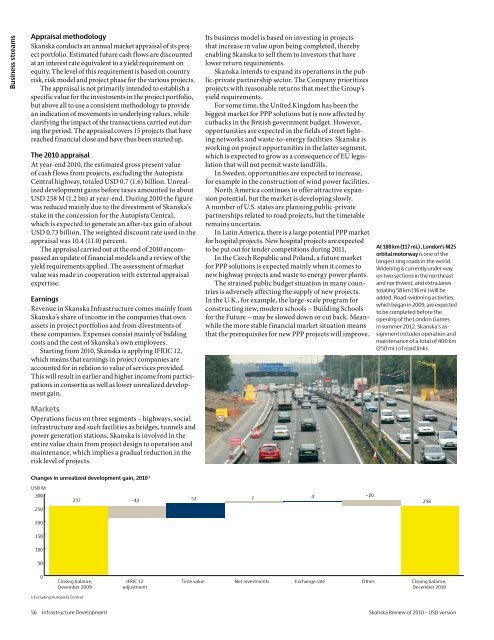Review of 2010 â USD version - Skanska
Review of 2010 â USD version - Skanska
Review of 2010 â USD version - Skanska
You also want an ePaper? Increase the reach of your titles
YUMPU automatically turns print PDFs into web optimized ePapers that Google loves.
Business streams<br />
Appraisal methodology<br />
<strong>Skanska</strong> conducts an annual market appraisal <strong>of</strong> its project<br />
portfolio. Estimated future cash flows are discounted<br />
at an interest rate equivalent to a yield requirement on<br />
equity. The level <strong>of</strong> this requirement is based on country<br />
risk, risk model and project phase for the various projects.<br />
The appraisal is not primarily intended to establish a<br />
specific value for the investments in the project portfolio,<br />
but above all to use a consistent methodology to provide<br />
an indication <strong>of</strong> movements in underlying values, while<br />
clarifying the impact <strong>of</strong> the transactions carried out during<br />
the period. The appraisal covers 15 projects that have<br />
reached financial close and have thus been started up.<br />
The <strong>2010</strong> appraisal<br />
At year-end <strong>2010</strong>, the estimated gross present value<br />
<strong>of</strong> cash flows from projects, excluding the Autopista<br />
Central highway, totaled <strong>USD</strong> 0.7 (1.6) billion. Unrealized<br />
development gains before taxes amounted to about<br />
<strong>USD</strong> 258 M (1.2 bn) at year-end. During <strong>2010</strong> the figure<br />
was reduced mainly due to the divestment <strong>of</strong> <strong>Skanska</strong>’s<br />
stake in the concession for the Autopista Central,<br />
which is expected to generate an after-tax gain <strong>of</strong> about<br />
<strong>USD</strong> 0.73 billion. The weighted discount rate used in the<br />
appraisal was 10.4 (11.0) percent.<br />
The appraisal carried out at the end <strong>of</strong> <strong>2010</strong> encompassed<br />
an update <strong>of</strong> financial models and a review <strong>of</strong> the<br />
yield requirements applied. The assessment <strong>of</strong> market<br />
value was made in cooperation with external appraisal<br />
expertise.<br />
Earnings<br />
Revenue in <strong>Skanska</strong> Infrastructure comes mainly from<br />
<strong>Skanska</strong>’s share <strong>of</strong> income in the companies that own<br />
assets in project portfolios and from divestments <strong>of</strong><br />
these companies. Expenses consist mainly <strong>of</strong> bidding<br />
costs and the cost <strong>of</strong> <strong>Skanska</strong>’s own employees.<br />
Starting from <strong>2010</strong>, <strong>Skanska</strong> is applying IFRIC 12,<br />
which means that earnings in project companies are<br />
accounted for in relation to value <strong>of</strong> services provided.<br />
This will result in earlier and higher income from participations<br />
in consortia as well as lower unrealized development<br />
gain.<br />
Its business model is based on investing in projects<br />
that increase in value upon being completed, thereby<br />
enabling <strong>Skanska</strong> to sell them to investors that have<br />
lower return requirements.<br />
<strong>Skanska</strong> intends to expand its operations in the public-private<br />
partnership sector. The Company prioritizes<br />
projects with reasonable returns that meet the Group’s<br />
yield requirements.<br />
For some time, the United Kingdom has been the<br />
biggest market for PPP solutions but is now affected by<br />
cutbacks in the British government budget. However,<br />
opportunities are expected in the fields <strong>of</strong> street lighting<br />
networks and waste-to-energy facilities. <strong>Skanska</strong> is<br />
working on project opportunities in the latter segment,<br />
which is expected to grow as a consequence <strong>of</strong> EU legislation<br />
that will not permit waste landfills.<br />
In Sweden, opportunities are expected to increase,<br />
for example in the construction <strong>of</strong> wind power facilities.<br />
North America continues to <strong>of</strong>fer attractive expansion<br />
potential, but the market is developing slowly.<br />
A number <strong>of</strong> U.S. states are planning public-private<br />
partnerships related to road projects, but the timetable<br />
remains uncertain.<br />
In Latin America, there is a large potential PPP market<br />
for hospital projects. New hospital projects are expected<br />
to be put out for tender competitions during 2011.<br />
In the Czech Republic and Poland, a future market<br />
for PPP solutions is expected mainly when it comes to<br />
new highway projects and waste to energy power plants.<br />
The strained public budget situation in many countries<br />
is adversely affecting the supply <strong>of</strong> new projects.<br />
In the U.K., for example, the large-scale program for<br />
constructing new, modern schools − Building Schools<br />
for the Future − may be slowed down or cut back. Meanwhile<br />
the more stable financial market situation means<br />
that the prerequisites for new PPP projects will improve.<br />
At 188 km (117 mi.) , London’s M25<br />
orbital motorway is one <strong>of</strong> the<br />
longest ring roads in the world.<br />
Widening is currently under way<br />
on two sections in the northeast<br />
and northwest, and extra lanes<br />
totaling 58 km (36 mi.) will be<br />
added. Road-widening activities,<br />
which began in 2009, are expected<br />
to be completed before the<br />
opening <strong>of</strong> the London Games<br />
in summer 2012. <strong>Skanska</strong>’s assignment<br />
includes operation and<br />
maintenance <strong>of</strong> a total <strong>of</strong> 400 km<br />
(250 mi.) <strong>of</strong> road links.<br />
Markets<br />
Operations focus on three segments – highways, social<br />
infrastructure and such facilities as bridges, tunnels and<br />
power generation stations. <strong>Skanska</strong> is involved in the<br />
entire value chain from project design to operation and<br />
maintenance, which implies a gradual reduction in the<br />
risk level <strong>of</strong> projects.<br />
Changes in unrealized development gain, <strong>2010</strong> 1<br />
<strong>USD</strong> M<br />
300<br />
250<br />
4 −20<br />
257 –43 53 7<br />
258<br />
200<br />
150<br />
100<br />
50<br />
0<br />
Closing balance,<br />
December 2009<br />
IFRIC 12<br />
adjustment<br />
Time value Net investments<br />
Exchange rate Other Closing balance,<br />
December <strong>2010</strong><br />
1 Excluding Autopista Central<br />
56 Infrastructure Development <strong>Skanska</strong> <strong>Review</strong> <strong>of</strong> <strong>2010</strong> – <strong>USD</strong> <strong>version</strong>

















